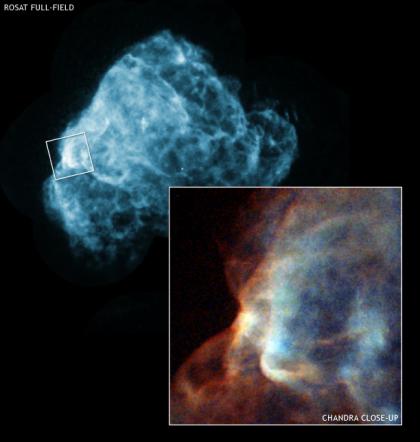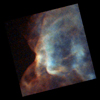Chandra Reveals Cloud Disrupted By Supernova Shock

Credit: Chandra: NASA/CXC/GSFC/U.Hwang et al.; ROSAT: NASA/GSFC/S.Snowden et al.
The Chandra three-color image (inset) of a region of the supernova remnant Puppis A (wide-angle view from ROSAT in blue) reveals a cloud being torn apart by a shock wave produced in a supernova explosion. This is the first X-ray identification of such a process in an advanced phase. In the inset, the blue vertical bar and the blue fuzzy ball or cap to the right show how the cloud has been spread out into an oval-shaped structure that is almost empty in the center. The Chandra data also provides information on the temperature in and around the cloud, with blue representing higher temperature gas.
The oval structure strongly resembles those seen on much smaller size scales in experimental simulations of the interaction of supernova shock waves with dense interstellar clouds (see sequence of laboratory images). In these experiments, a strong shock wave sweeps over a vaporized copper ball that has a diameter roughly equal to a human hair. The cloud is compressed, and then expands in about 40 nanoseconds to form an oval bar and cap structure much like that seen in Puppis A.
On a cosmic scale, the disruption of l0-light-year-diameter cloud in Puppis A took a few thousand years. Despite the vast difference in scale, the experimental structures and those observed by Chandra are remarkably similar. The similarity gives astrophysicists insight into the interaction of supernova shock waves with interstellar clouds.
Understanding this process is important for answering key questions such as the role supernovas play in heating interstellar gas and triggering the collapse of large interstellar clouds to form new generations of stars.
|
||||||||||||||||||||||||||||
The image features a supernova remnant named Puppis A, which is depicted in blue and burnished gold colors. The X-ray image of Puppis A shows two different views of the supernova remnant. In the upper left, the full field image reveals a bright blue structure. In the lower right, another view displays a close-up of a small piece of the supernova. Both structures appear to be shaped like filamentary and wavy gas clouds, with the full structure appearing like an irregular oval and the closeup just a square cutout of the larger oval. The Chandra image (the close-up) of the region Puppis A reveals a cloud being torn apart by a shock wave produced in a supernova explosion. This is the first X-ray identification of such a process in an advanced phase. In the inset, a blue vertical bar and a blue fuzzy ball or cap to the right show how the cloud has been spread out into an oval-shaped structure that is almost empty in the center. The Chandra data also provides information on the temperature in and around the cloud, with blue representing higher temperature gas. The bright blue oval wide-angle view is from ROSAT, a German-led X-ray telescope that operated in the 1990s.




